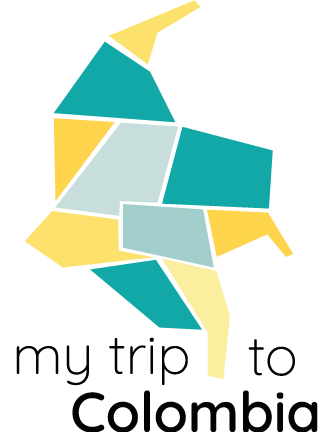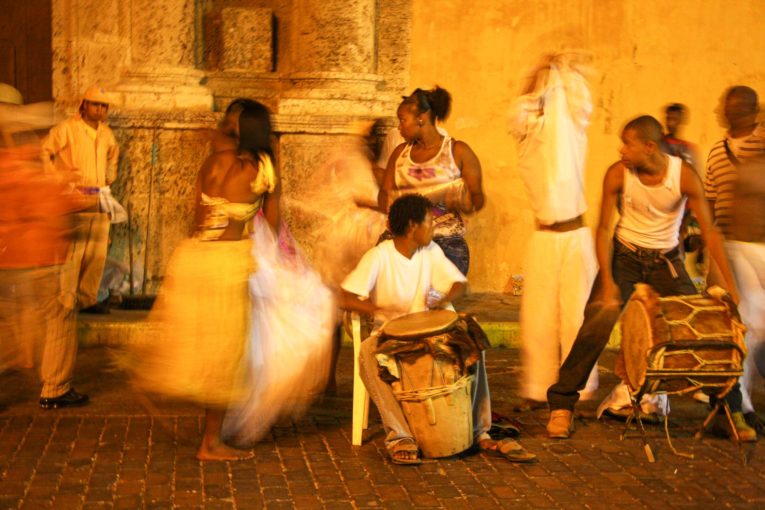It goes on! We’re starting a new section on our travel blog to open up a little more the field of the discovery of Colombian culture.
Music in Colombia is certainly the most widespread art form, and it would be impossible to talk about it in a general way without spending hours on it… so we’re going to tackle different subjects, different musical styles, without any claim to exhaustiveness, but with a great desire to share!
From the Gulf of Uraba to the Guajira desert, and all along the Magdalena river, the Caribbean region is certainly the producer of two of Colombia’s most emblematic musical styles: Cumbia and Vallenato.
In this post, we’ll try to introduce you to Cumbia . We called on our friend Christian, an afro-Colombian music enthusiast and connoisseur, to help Sam (who, if you didn’t know, was a professional musician with a musicology degree) write this post and give you as much information as possible!
Disclaimer: we apologize in advance for any grammatical or syntactic errors, as our native language is not English (we're a Colombian-French couple), so we hope you'll forgive us and still enjoy the information we share with you! Please note that all the information on our blog is based on our own experience, and is checked and updated regularly.
Contents
Related posts

Exclusive 5% Off Discount For you
Best Travel insurance for Colombia
Our partner offers the best rates and a 5% discount for our blog readers! (regardless of travel dates)
The origins of Cumbia
The backbone of Latin American music
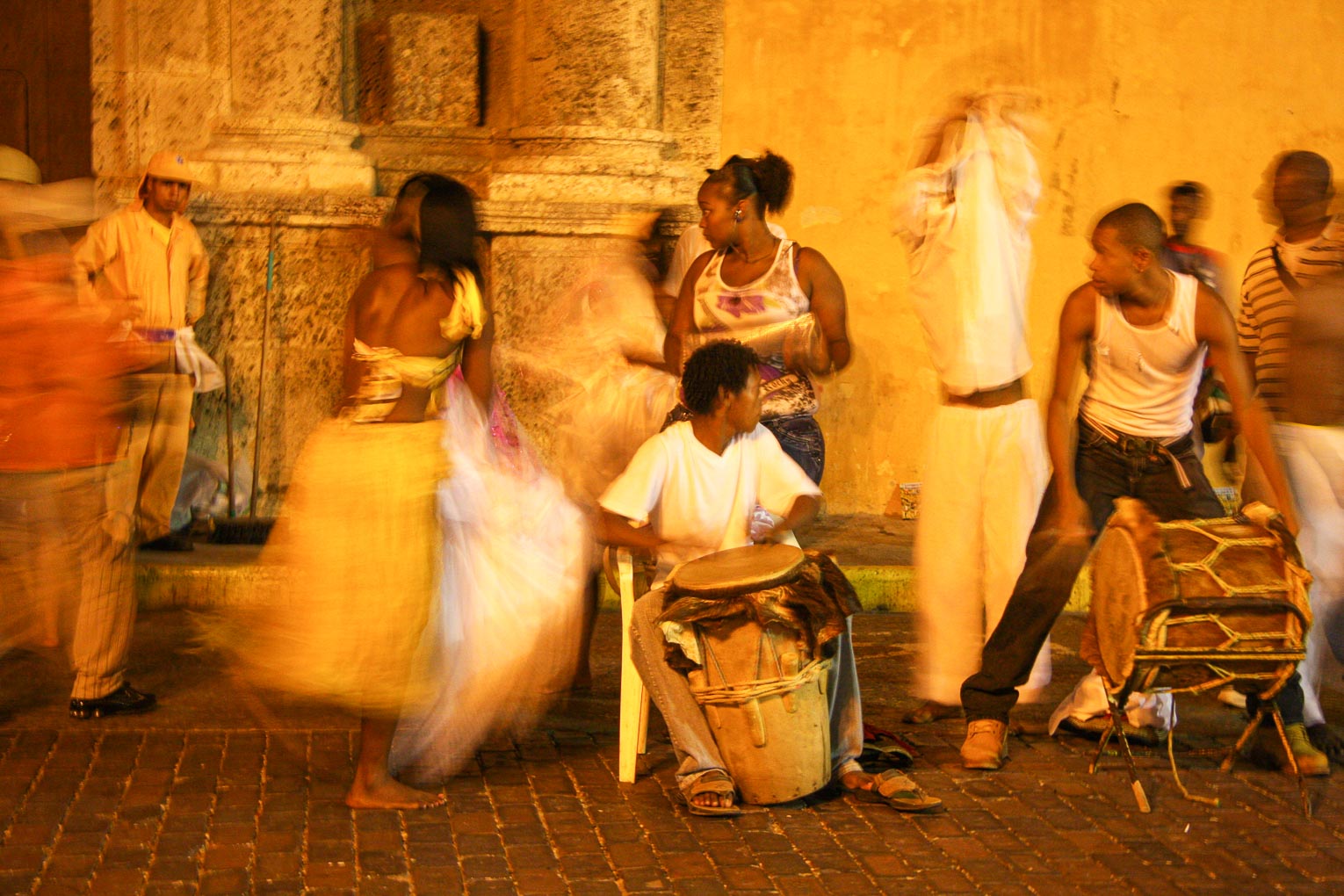
It’s important to know that the word “Cumbia” didn’t originally refer to a musical genre, but rather to an event, a party, before designating the music played there. It’s something you’ll find just about everywhere in Colombia. It’s the same, for example, with Joropo in Casanare and llanera music.
The origin of the word “Cumbia
There are two versions of the origin of the word “Cumbia “:
- The first gives a Bantu origin where the word “Kumba” would mean “to roar”, which would represent quite well the strength of the song that accompanies Cumbia. Moreover, “Kumbé” in Bantu refers to a dance from Equatorial Guinea.
- The second version gives an indigenous origin from the word “Cumbague”, which designated the indigenous Cacique (chief) of the Pocabuy region, i.e. the area between Mompox and El Banco where Cumbia was born (and where Colombia’s biggest Cumbia festival is held today)
Geographical origins of Cumbia
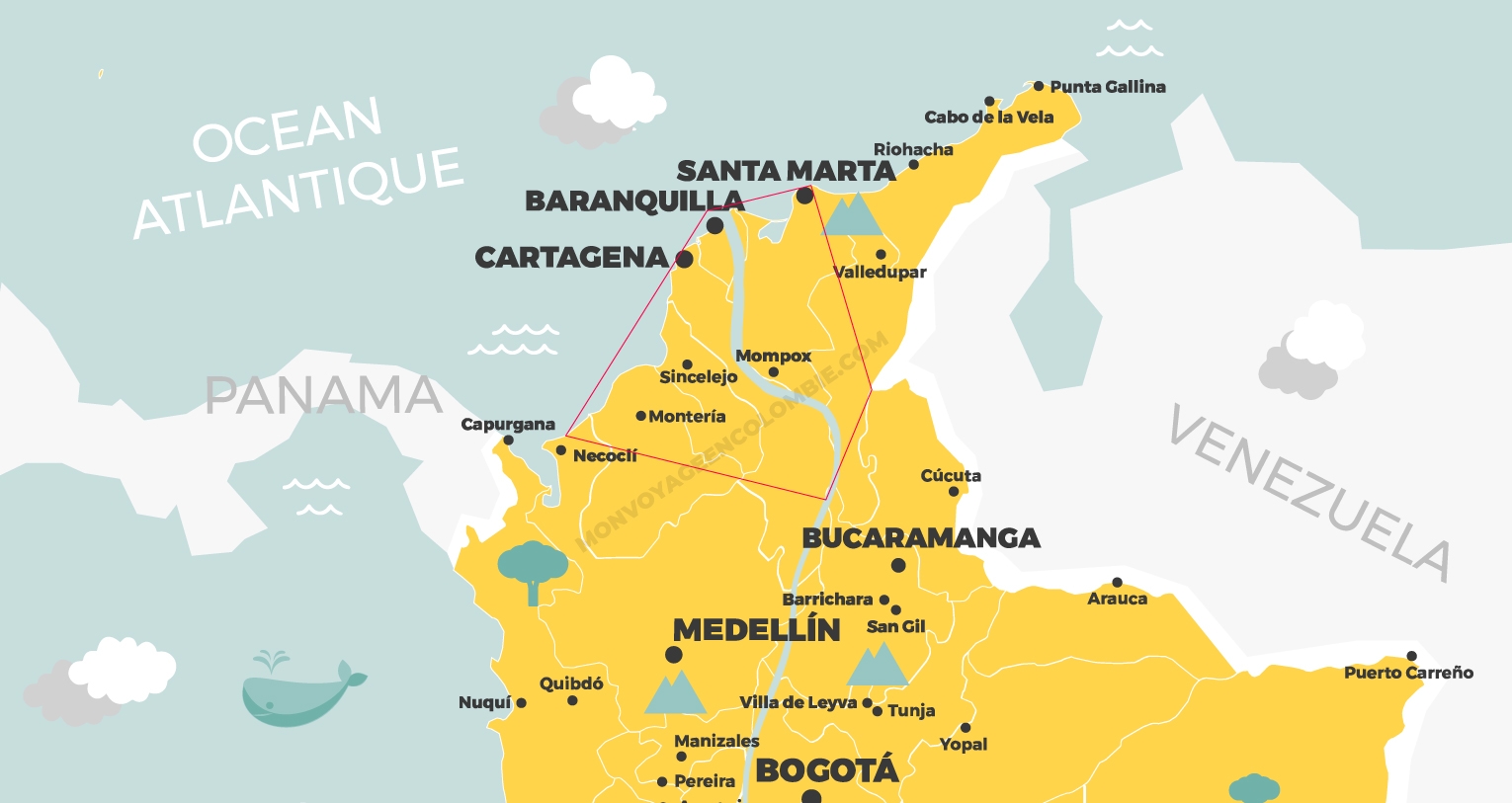
Of course, there’s no certainty about the exact birthplace of cumbia, but research suggests that it originated in the region around Mompox, formerly known by the indigenous name of Pocabuy (roughly the basin around Mompox and El Banco).
This theory has the merit of being based on writings from the colonial era relating the existence in this region of indigenous festivals held to the sound of flutes and drums.
Other specialists claim that Cumbia originated in Cartagena.
In any case, this music was to develop on both sides of the Magdalena river through the population of Santa Marta to El Banco, from Cartagena to the Montes de Maria, and as far as the department of Cordoba.
Cumbia, music of mixed influences
Music of Colombia
There are many theories about the musical influences of Cumbia, similar to those about the origin of the word, or the exact geographical area of its implantation..
Some insist on Cumbia’s indigenous origins, others that it is primarily Afro in origin. But one thing is certain: this is a music of mixed origins.
The percussion
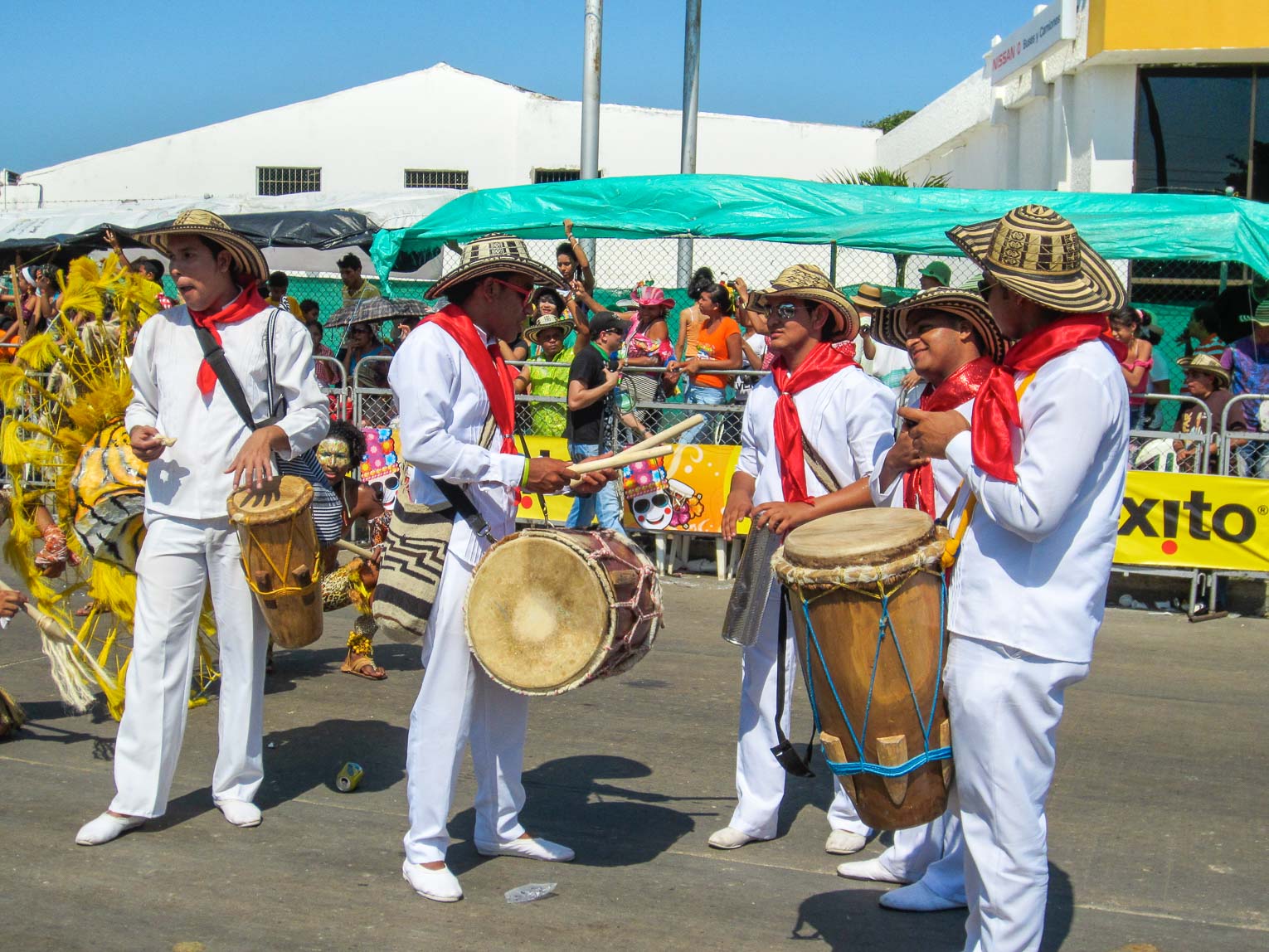
The drums used in Cumbia have both African and indigenous origins. There are three main types of drum:
- Llamador: the smallest drum, used simply to set the tempo.
- Alegre: this is the drum that sings along with the melody, and is the most virtuoso of the three, with the freedom to improvise.
- Tambora: the equivalent of the bass drum, it plays the bass and accompanies the melody. The woodwind part is also played like a clave/bell. Writings from the early 19th century describe this percussion accompanying the gaïtas at indigenous festivals.
Depending on the group, additional percussion instruments such as the Maraca or the Guache (a tube filled with seeds) are used to accentuate the rhythm in addition to the Llamador. Both these instruments are of indigenous origin.
In Cumbia de Gaïta groups, the Maraca is always used by the macho Gaïta player.
Wind instruments
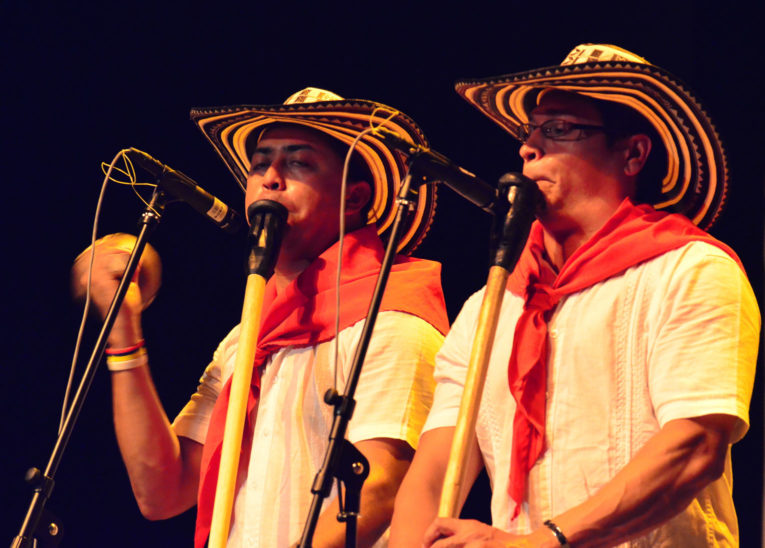
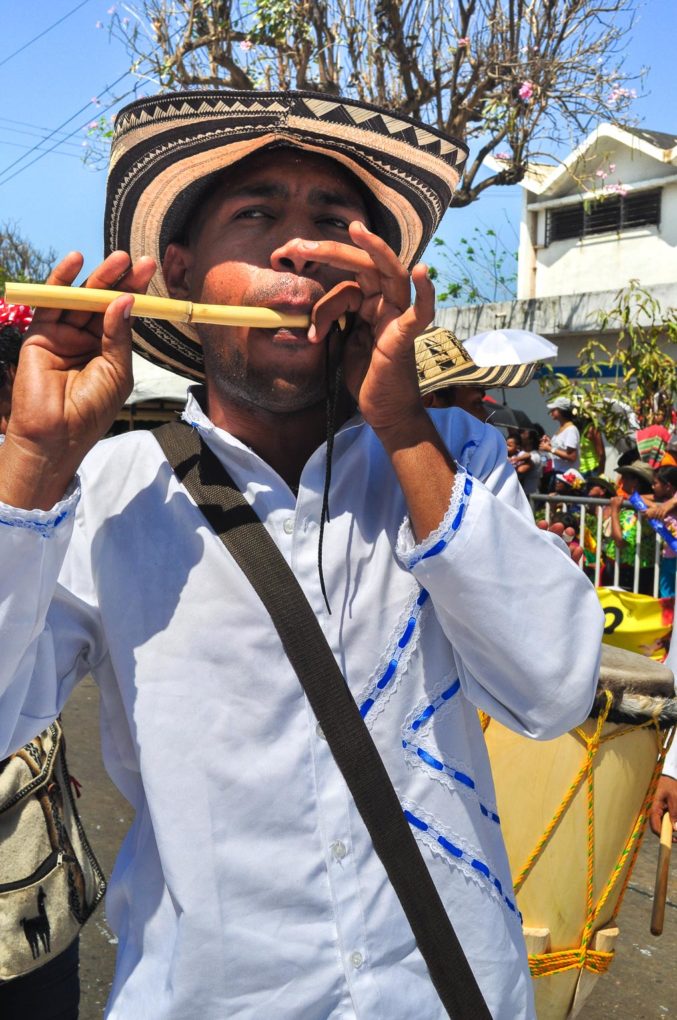
The Gaïta and the caña de Millo are the two original instruments used to play the Cumbia melody. Incidentally, these instruments are often referred to as flutes, when in fact they are reed instruments. While we are certain of the Gaïta’sindigenous origins, the caña de Millo is thought by some to be of African origin, as it is an instrument found notably in Sudan:
- The Gaïta: carved from the heart of a cactus, the Gaïta is a wind instrument played in pairs. The “male/macho” Gaïta plays the bass with one hand, holding the maracas in the other, while the “female/hembra” Gaïta plays the melody with both hands.
- The caña de Millo: carved from reed or any other hollow stem, this much smaller instrument is played horizontally, replacing the Gaïta in some regions.
The dance

Cumbia dance is said to have influences from European dances (fandango). There are different “baile” depending on the circumstances (traditional, parade, salon, stage, etc.). It’s a seduction dance, a common parade where the man tries to seduce the woman while she pushes him away with a lighted candle.
To give you a schematic idea, traditionally :
- The men dance bent over, pivoting on one foot and circling the women. They take off their hats, make mimicry and seductive gestures, in other words: they strut their stuff.
- The women, with a gentle sway, remain upright and dignified, holding their dresses in one hand and a lighted candle in the other to ward off evil spirits and male assaults.
The costumes
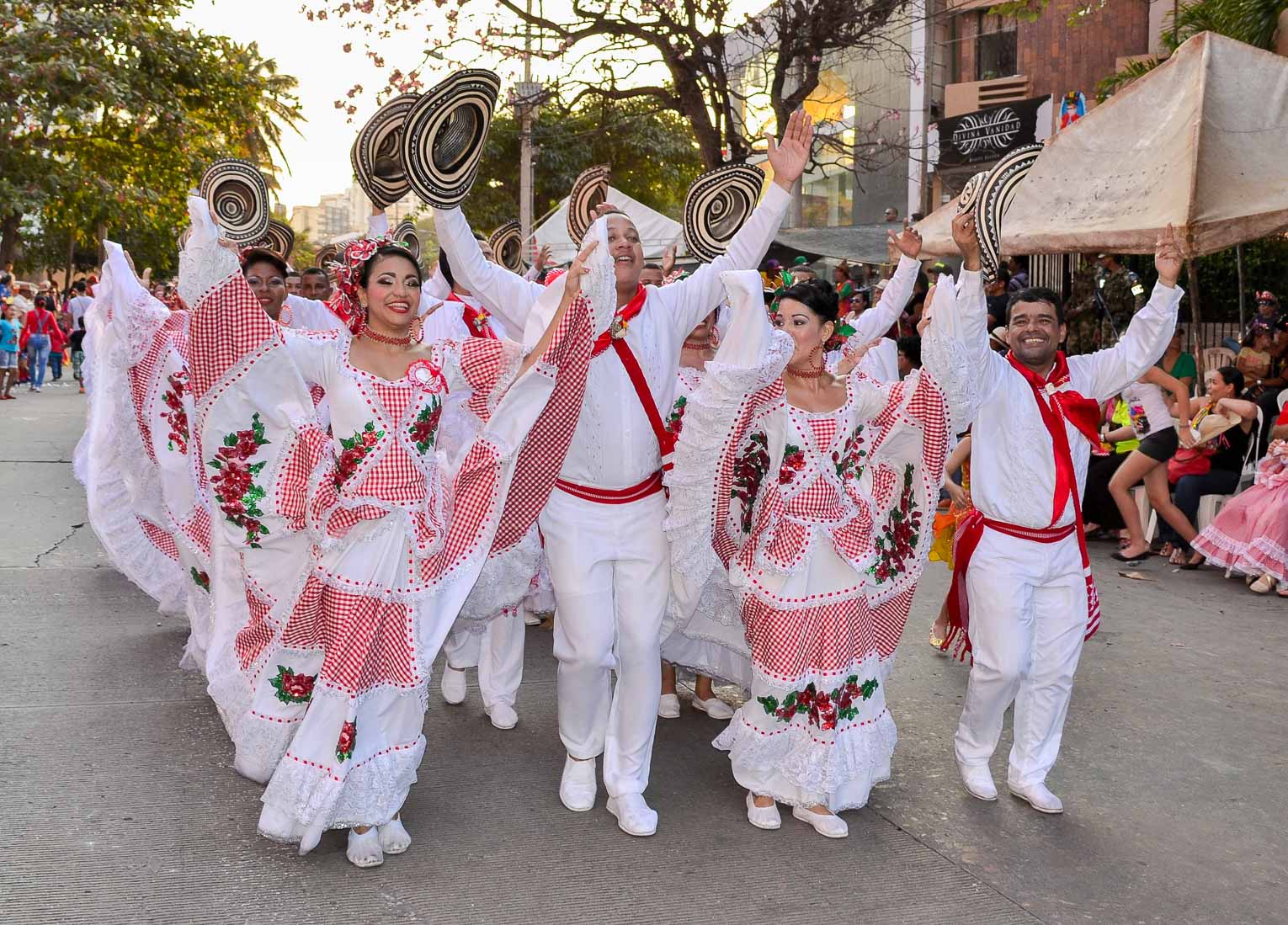
For Cumbia costumes, it’s a little more obvious to see theSpanish influence, even if some elements are directly linked to indigenous culture:
- For women: the “pollera” is a ruffled dress that Spanish women brought back to colonial times. Traditionally red and white with checks.
- For men: the red scarf and white garments are reminiscent of Basque festayres.
For men, however, there are indigenous influences in the form of the Mochila shoulder bag (used by various indigenous populations) and the Sombrero vueltiao (Zenu origin)
A brief chronology of Cumbia
music from Colombia
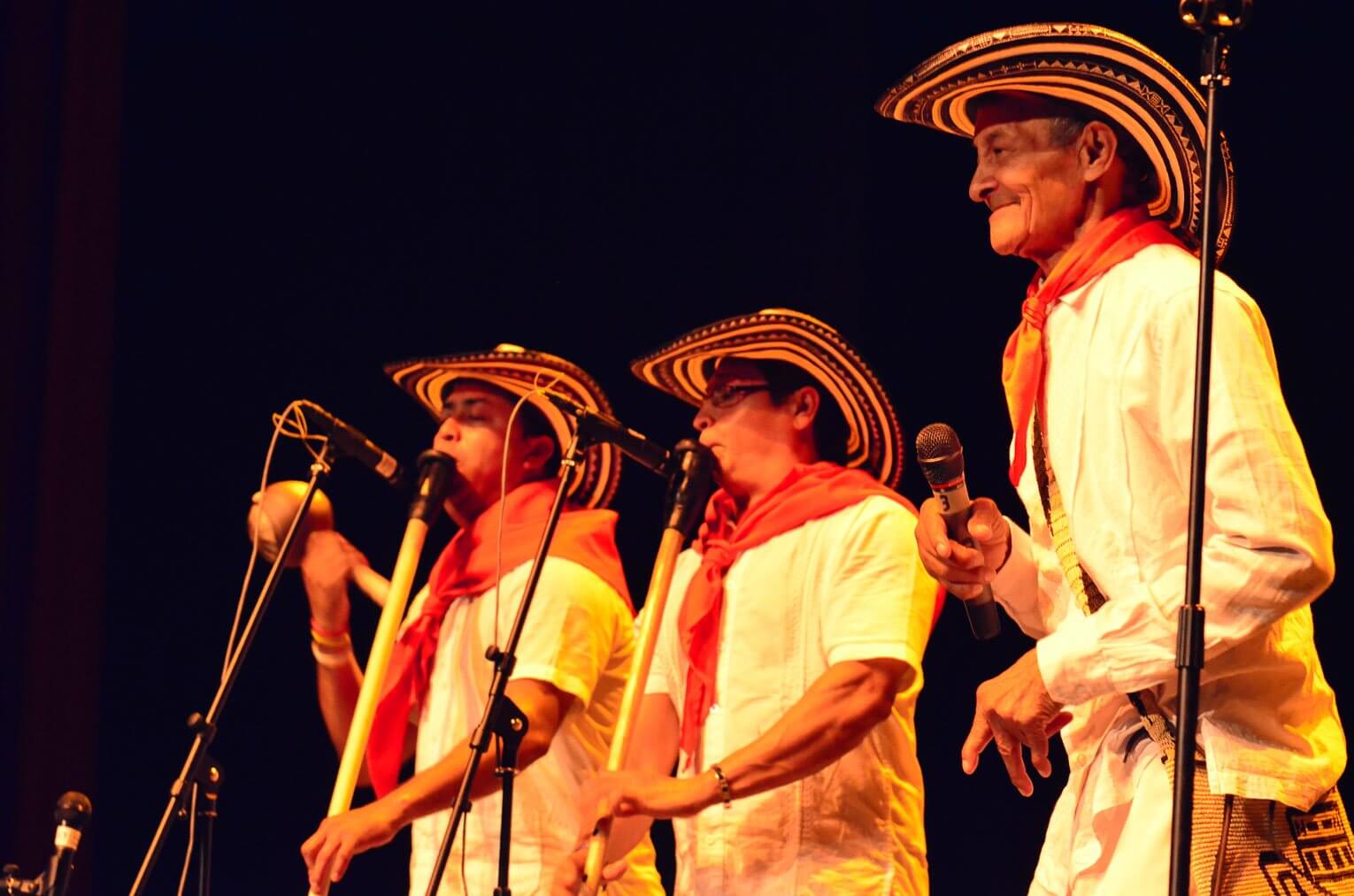
Colombian music is first and foremost a story of rhythms and dances linked to particular events in life. Colombian music is therefore first and foremost and ontologically a social history. Moreover, this is something that is not specific to Colombia, but can be found all over the world.
Cumbia is no exception to the rule. Initially a social event, “cumbia” as a musical genre did not exist until late in its history. Here’s a quick chronological history of Cumbia.
- 1580s – Written accounts of indigenous Chimillas festivals in Pocabuy (Mompox), where the gaïta and tambora are described.
- 1865 – Writings describe parties where people dance to the sound of African percussion played by slaves and gaïtas played by natives.
- 1877 – Creation of the “Cumbia soledeña” group, considered one of the “first” officially constituted Cumbia groups in Colombia.
- 1934 – Creation of the “Discos Fuentes” label and first recordings. It becomes necessary to label musical genres in order to sell them. Cumbia becomes an official genre, and the advent of electric instruments takes traditional music into another dimension.
- 1940s – Colombian cumbia establishes itself throughout the country as a popular musical genre in its own right, and begins to be exported to other Latin American countries through radio broadcasts and record sales.
- 1960s – This is the golden age of Colombian cumbia, with the creation of cumbia groups that remain popular to this day.
- 2000s – Electronic music takes hold of Cumbia, which becomes a hyper-trendy musical genre, creating a new golden age for Cumbia after that of the 1960s.
- 2013 – The Festival Nacional de Cumbia de El Banco is declared Colombia’s national heritage.
The different styles of Cumbia
Colombian music
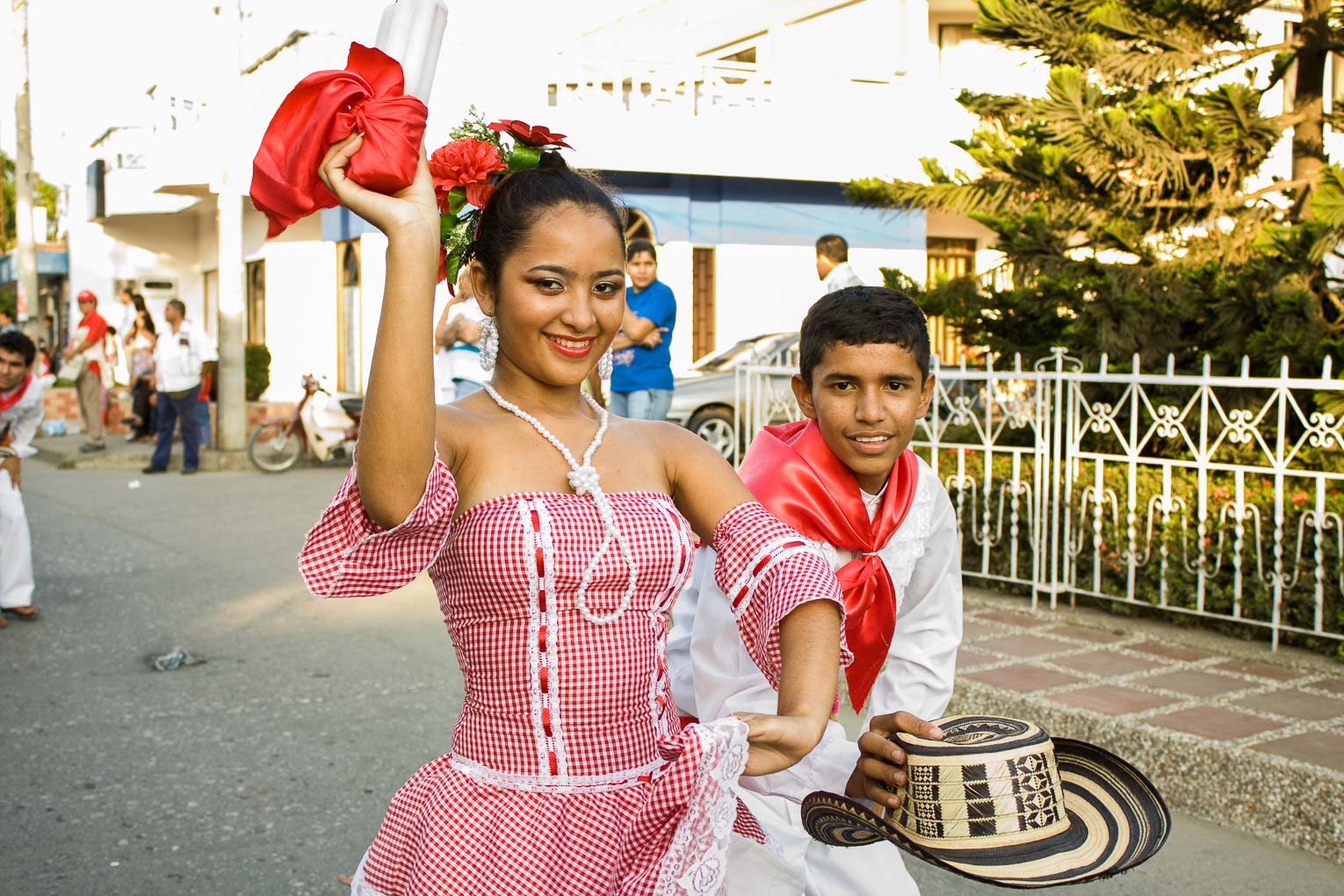
As we’ve already said, the Cumbia musical genre originated in the popular fiestas of the 19th century, where the music’s identity developed. Over the course of time, variations have emerged, through the addition/removal of certain instruments or simply through historical evolution and cross-fertilization with other influences.
Today, cumbia can be divided into several genres:
- Cumbia de Gaïta
- Cumbia de Millo
- Cumbia sabanera
- Cumbia d’orquestre tropical
- Electro cumbia
- etc.
Cumbia is one of Colombia’s cultural heritages, and there are some great figures who represent this musical genre in their own right. Here are just a few of the highlights of Colombian cumbia.
Cumbia de gaïta
Cumbia de gaïta is considered to be the original Cumbia, the encounter between percussion and the gaïta, between the traditions of African slaves and those of the indigenous people of the Caribbean region.
LOS GAÏTEROS DE SAN JACINTO is one of the greatest exponents of this original Colombian cumbia. San Jacinto is a village located in the Montes des Maria, south of Cartagena, the land of Cumbia. A guardian of history and tradition, los Gaïteros de San Jacinto, with the quality of its musicians and the authenticity of its singers, have raised the profile of the genre and exported it beyond Colombian borders.
Here’s a mini report on los Gaiteros de San Jacinto that will give you an insider’s view of what traditional Cumbia is all about.
Cumbia de Millo
Cumbia de Millo is, as the name suggests, Cumbia played with the caña de Millo, the other wind instrument of indigenous origin used to play the melody in certain regions. Like San Jacinto for the Gaïta, the caña de Millo has made a name for itself in the village of Soledad, south of Barranquilla.
PEDRO RAMAYA BELTRAN, a native of Soledad, is considered one of the greatest exponents of Cumbia de Millo.
Cumbia sentada
Cumbia sentada (sitting cumbia) is cumbia without wind instruments. It’s a cumbia that’s only sung and accompanied by percussion, so it can be played sitting down. It can be found in what might be called Palenque Cumbia
TOTO LA MOMPOSINA is certainly the greatest living exponent of traditional music from Colombia and the Caribbean in general. But even if her repertoire is not limited to traditional Cumbia, her great voice has brought Cumbia Sentada to the top, and the famous song “El Pescador” is a good illustration of this.
Cumbia de Banda or Pelayera
As its name suggests.cumbia de banda is played by a brass band. It’s called Pelayera because the village of San Pelayo, between Monteria and Santa Cruz de Lorica, is one of its claimed strongholds. Every year, a festival of bandas is held here. Bandas gather to celebrate this musical genre, which originated in Spain and has also taken root in Colombia.
PEDRO LAZA is the great figure of musica de banda with his refined music. But if you look hard enough, you’ll find that local brass bands can sometimes have a rootsy sound that makes for a very special “Sabor”!
Cumbia Sabanera
Cumbia Sabanera comes from the savannahs of the Caribbean region (department of Sucre, Cordoba and Bolivar), where the accordion replaces traditional indigenous instruments such as the Gaïta and the Caña de Millo. The accordion is an instrument imported to Colombia by the Germans at the end of the 19th century, and it was to flood many musical genres. Cumbia is no exception!
LIZANDRO MEZA AND ANDRES LANDERO are the most famous representatives of Cumbia sabanera. The main instrument here is the accordion, but you can still feel the influence of traditional Cumbia with the presence of percussion.
CARMELO TORRES is regarded today as the guarantor of the Sabanera tradition, and here he plays “La Pava Congona”, one of the great classics of Cumbia Sabanera.
Tropical Cumbia
Tropical Cumbia emerged roughly with the arrival of the “Discos Fuentes” label in the 1940s. Musicians went into the studio, and traditional instruments were no longer used. They had to appeal to the widest possible audience, and to achieve this they added modern instruments (electric guitars and basses, keyboards, brass and saxophones…) to form large Cumbia orchestras.
RODOLFO AICARDI, nicknamed “El rey de diciembre” for his ability to ignite the living-room dancefloors of every Colombian family during the Christmas holidays, is certainly the emblematic figure of tropical Cumbia for the “Discos Fuentes” label.
The interplanetary hit “La Colegiala” springs to mind! This is definitely a departure from tradition, with the use of modern instruments (drums, bass and electric guitar, synths, brass, saxophones, etc.).
Another unmissable classic, one of the many unofficial anthems of all Colombians: Colombia, Tierra querida by LUCHO BERMUDEZ !
Cumbia electro
From the 1990s/2000 onwards, young musicians, particularly from the electro and hip-hop worlds, began to take an interest in traditional music and to mix sounds. In all Latin American countries, new groups influenced by traditional rhythms were being formed, and Argentina was ahead of the game. But Colombian musicians were soon catching on too.
LA MOJARRA ELECTRICA are certainly the pioneers of the genre. Founded in Bogotá in 2001 by musicians committed to research into Afro-Colombian music from the Caribbean and the Pacific, urban music, jazz and Afrobeat – in short, open music!
SYSTEMA SOLAR, founded in 2006 in Santa Marta, is another Colombian group that has become a must-see today. They bring to traditional Sound System all the contributions of traditional Colombian music, champeta, salsa, vallenato and, of course, Cumbia!
BOMBA ESTEREO quickly became one of the best-known Colombian bands of the 2000s. Founded in 2006 in Bogotá, they have clearly oriented their music towards electro cumbia.
PUERTO CANDELARIA, formed in 2000 in Medellin, whose leader is one of Colombia’s hottest young composers and arrangers. With strong jazz influences, they started out in a totally wild genre, mixing modern and traditional music with a lot of humor. In 2019 they released a much more serious album of covers, a tribute to Tropical Cumbia, which won the Latin Grammy Award for Best Cumbia Album.
They’re not Colombian, but came to settle in Colombia, attracted by the richness of its traditional music. Bringing their influence from the European scene, they will participate in this fusion of genres.
SIDESTEPPER, an English DJ, moved to Bogotá in the 1990s and can be considered one of the pioneers of the genre.
QUANTIC, a Dutch DJ, moved to Cali in the 2000s to do the same kind of work.
Yo me llamo Cumbia
Colombian music
It’s impossible not to end this post with the national emblem, “Yo me llamo cumbia“, a song written by Mario Gareña in the 1960s, here in a version revisited by Toto La Momposina. We’ve left the lyrics below and translated them for you to enjoy.
Yo me llamo cumbia, yo soy la reina por donde voy
No hay una cadera que se este quieta donde yo estoy
Mi piel es morena como los cueros de mi tambor
Y mis hombros son un par de maracas que besa el sol. (bis)
Llevo en la garganta una fina flauta que Dios me dio
Canuto de millo, olor de tabaco, aguardiente y ron.
Cojo mi mochila, enciendo la vela y repica el son.
Y enredo en la luna con las estrellas toda mi voz. (bis)
Como soy la reina, me hace la corte un fino violin
Me enamora un piano, me sigue un saxo oigo un clarin
Y toda la orquesta forma una fiesta en torno de mi
Y yo soy la cumbia, la hembra coqueta bailo feliz. (bis)
Yo naci en las bellas playas caribes de mi pais
Soy Barranquillera, Cartagenera, yo soy de ahi
Soy de Santa Marta, soy Monteriana, pero eso si
Yo soy Colombiana, ¡oh! tierra hermosa donde naci. (bis)
Como soy la reina, me hace la corte un fino violin
Me enamora un piano, me sigue un saxo oigo un clarin
Y toda la orquesta forma una fiesta en torno de mi
Y yo soy la cumbia, la hembra coqueta bailo feliz. (bis)
Yo naci en las bellas playas caribes de mi pais
Soy Barranquillera, Cartagenera, yo soy de ahi
Soy de Santa Marta, soy Monteriana, pero eso si
Yo soy Colombiana, ¡oh! tierra hermosa donde naci. (bis)
Y mis hombros son un par de maracas que besa el sol.
Y enredo en la luna con las estrellas toda mi voz.
Yo soy Colombiana, ¡oh! tierra hermosa donde naci.
My name is cumbia, I’m the queen where I go
It’s impossible not to sway when I’m around
My skin is as brown as the skins on my drum
And my shoulders are a pair of maracas that kiss the sun.
I have a fine flute in my throat that God gave me
Tube of reed, smell of tobacco, aguardiente and rum.
I take my mochila, light the candle and the bell rings.
And I tangle my voice with the moon and the stars
Since I’m the queen, an excellent violin courts me
A piano seduces me, a saxophone follows me, I hear a clarinet
And the whole orchestra forms a party around me
And I am the cumbia, the coquettish woman and I dance with joy.
I was born on the beautiful Caribbean beaches of my country
I’m Barranquillera, Cartagenera, that’s where I’m from
I’m from Santa Marta, I’m Monteriana, but most of all
I’m Colombian, oh, beautiful land of my birth.
Where to hear and see Cumbia
Music from Colombia
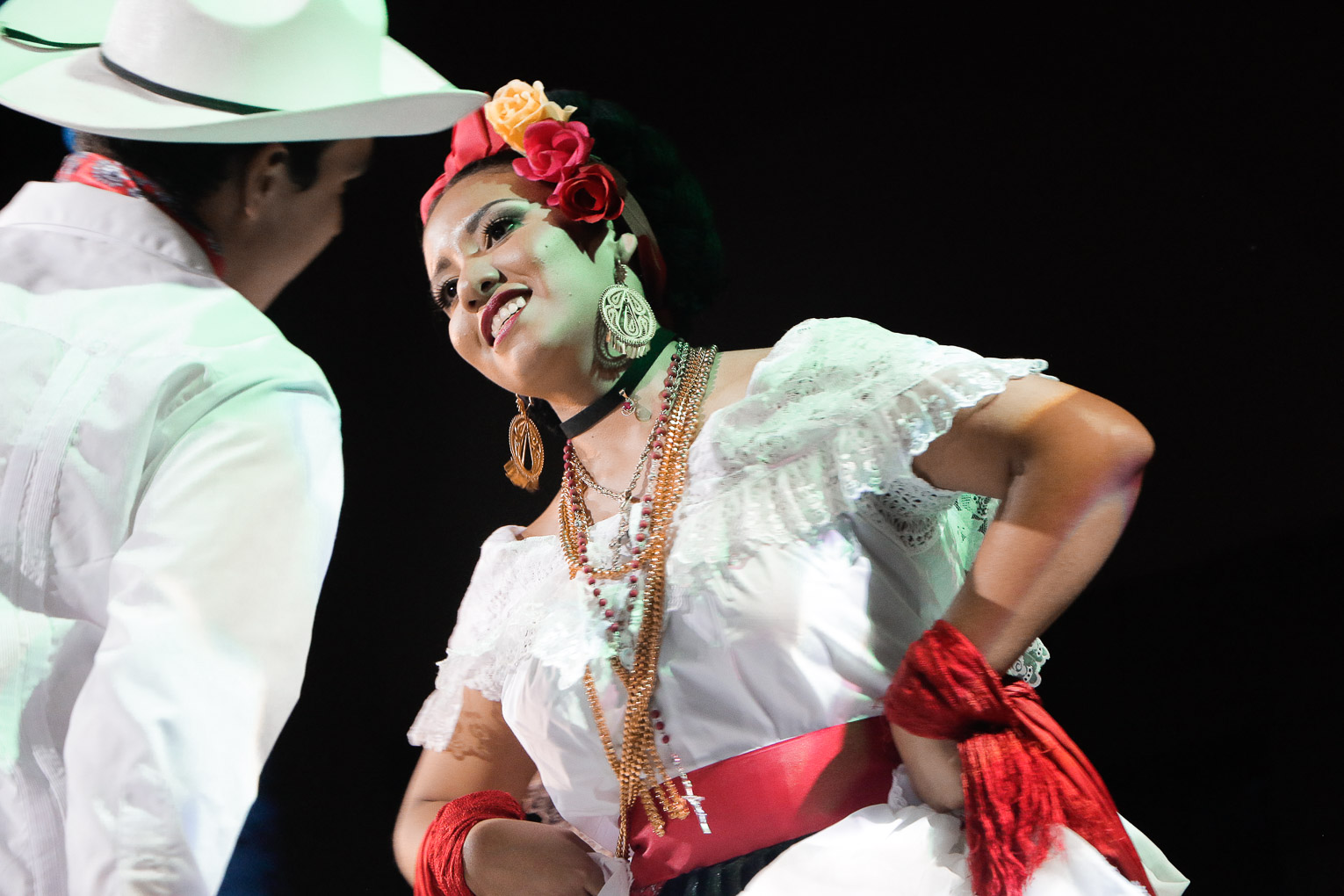
That’s a tough question to answer! Whatever one may think, Cumbia is not the most listened to or played musical genre in Colombia today, and it will be difficult to find clubs where bands perform.
The first solution is to follow the concert agendas in Colombia and see if the artists you prefer are playing somewhere.
For the more adventurous and those who love discovery, it’s by going to the villages on the Caribbean coast where Cumbia was born and where great artists have emerged that you may have the chance to meet musicians and talk to them about the subject
- San Jacinto (Bolivar)
- Ovejas (Sucre)
- Morroa (Sucre)
- El Banco (Magdalena)
- San Pelayo (Cordoba)
- Soledad (Atlantico)
Festivals
The surest way to discover the Cumbiambera tradition is to visit traditional music festivals or local fiestas where Cumbia and its derivatives take center stage.
- January – Fiestas de la Virgen de la Candelaria in Cartagena (Bolivar)
- February-Carnaval de Barranquilla (Atlantico)
- March – Festival de Gaitas in Ovejas (Sucre)
- June -Festivalnacional de la Cumbiamba in Cereté (Cordoba)
- June – Festival de Porro in San Pelayo (Cordoba)
- June -Festival Nacional del Pito Atravesao in Morroa (Sucre)
- July – Cumbia Festival in El Banco (Magdalena)
- July -Festivalde Decimeros y Bailadores de Cumbia in Malambo (Atlantico)
- August – Festival Nacional Autóctono de San Jacinto (Bolivar)
- August – Colombia al Parque in Bogota (Cundinamarca)
- December – Festival Cumbias, Polleras y Sombreros en Manatí (Atlantico)
Clubs and Bars
You can also try your luck here, as these clubs, bars and restaurants sometimes offer DJ sets featuring cumbia:
- Boogaloop Club in Bogotá
- Casa de citas in Bogotá
- Latino Power in Bogota
Sorry, we haven’t found any addresses other than Bogotá yet. If you know of any, please let us know in the comments!
Bonus Cumbia Mix
Tom Stakhanov spent several years in Colombia, hanging around the country’s most obscure vinyl stores in search of rare editions of Colombian music. A good part of his finds concerned old Cumbia, and Tom has given us the pleasure of creating a mix of his best discoveries especially for My Trip to Colombia! A Bailar!
